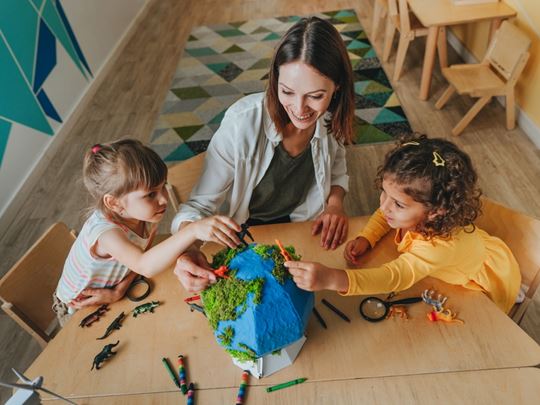Whether you are a foster parent or are thinking about fostering, you may ask yourself, ‘How can I encourage my foster child’s development’?
Our answer: creative play!
Fostering with the FCA means you are not alone on your fostering journey. You’re part of a community dedicated to improving outcomes for all our foster children and young people. We understand that children with complex pasts need time to heal through therapy and other innovative means.
Creative play helps build the foundations for a child’s emotional, motor and problem-solving skills. Not only that, creative play can be a fundamental part of therapy for trauma and attachment, along with supporting those who have special educational needs and disabilities.
Creative play comes in a variety of forms, from painting to playing instruments and from dancing to baking. With so many options, play is an easy way to encourage your foster child’s development and strengthen your bond.

What is creative play in child development?
From the moment a child is born, they are absorbing their surroundings. Their senses are helping them to understand the world. Creative play starts here. When a child looks at a mobile, respond to your voice or makes seemingly random movements, they are beginning to learn through play. When they are toddlers, they may respond non-verbally by swaying to music or laughing. As they grow, they may act out stories and become storytellers themselves.
The Early Years Foundation Stage (EYFS) framework explains that children can react to creative play emotionally, physically, socially, culturally or a combination of these, learning and discovering through play. Creative play is about giving your foster child the freedom to express themselves.
Things to consider when you are engaging a child in creative play:
- There should be no set goal; creative play encourages freedom.
- Value your foster child’s vision and contribution; there is no right way to be creative.
- Give your foster child enough time and space to explore and experiment; they may prefer one type of creative play over another.
- Nurture their curiosity and creativity so they’ll be passionate about engaging in creative play regularly.
Types of play in child development
There are numerous types of play in child development; they often encompass each other, and the benefits overlap. Play can happen inside the home, outside or at another venue.
- Physical play encourages children to get active and enhance motor skills. They could play hide and seek or use a hula hoop.
- Sensory play stimulates the senses and is brilliant for supporting autistic children to process sensory information. Baking, water play and interacting with nature are accessible sensory activities.
- Role play in child development can aid children in practising their social skills through real-life scenarios like going to the doctor’s or supermarket.
- Imaginative play gives children the freedom to use their imaginations to create stories. They could have magical powers and bring their toys into their imaginary world to process trauma.
- Arts and Crafts play lets children create anything they want using various materials. It provides a safe place for children to express their emotions and builds the foundations for a love of creation.

Benefits of play in child development
Tips to help introduce your foster child to creative play
FCA celebrates play; however, some children may initially find creative play overwhelming due to trauma or a lack of experience in play. They may not know how to react to new toys or arts and crafts materials, so here are some tips for introducing creative play to your foster children:
- Start slowly, introducing various methods of play in stages.
- If your foster child has never experienced play, too much choice could leave them feeling overwhelmed, so it’s ideal for them to pick a toy from a small selection.
- Give your foster child praise for playing; hopefully, this will motivate them to play again.
- If your foster child has a favourite TV programme, you can relate your creative play to this, for example, by re-enacting scenes and scenarios from the TV show.
- Join in and demonstrate to your foster child how to play.
- Encourage your foster child to spend time with other children; watching other children play could help your foster child learn how to play.
- Read to your foster child; stories will help their imagination grow.
- To help your foster child role play, take them to the supermarket or a local coffee shop to give them real-life scenarios to practice.

If you would like any further guidance, our therapy service is available to support both you and your foster child. The service will help you better understand your foster child and will deliver additional support to assist you on your fostering journey.
Creative play starts young, but there is no upper age limit. The FCA hosts events to promote creativity in all ages, such as family fun days and charity art workshops. If you are already fostering or are thinking about fostering, contact us for more information on the events happening in your area.




